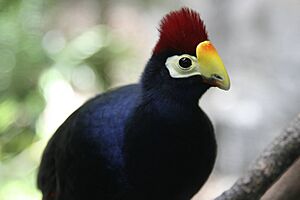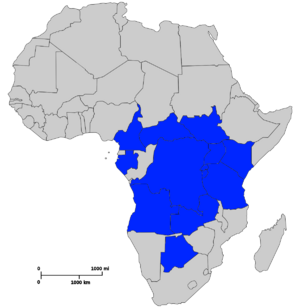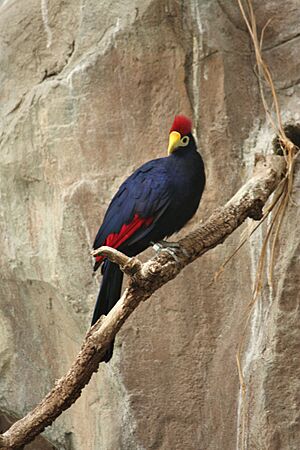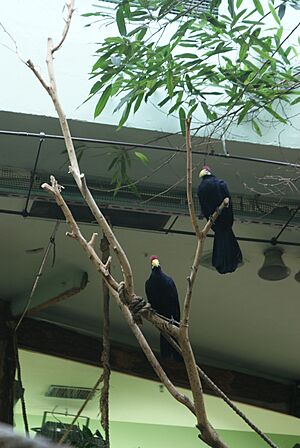Ross's turaco facts for kids
Quick facts for kids Ross's turaco |
|
|---|---|
 |
|
| Conservation status | |
| Scientific classification | |
 |
The Ross's turaco (also called Lady Ross's turaco) is a beautiful bird from Africa. Its scientific name is Tauraco rossae. This bird is mostly a bright bluish-purple color. It belongs to the turaco family, called Musophagidae.
Contents
Meet the Ross's Turaco: Characteristics
Ross's turacos are easy to spot! Both male and female birds look very similar. They are a deep blue color with bright red feathers on their heads. They also have red feathers in their wings.
What Do They Look Like?
Male turacos have a bright yellow beak. Females might have a slightly more yellow-green beak. Both have an orange shield-like part on their forehead. Their wings are round and short. This shape helps them fly in short, fast bursts.
Size and Movement
These birds have black legs. They have three toes pointing forward and one toe that can turn backward. This special toe helps them climb easily through tree branches. Ross's turacos are about 15 to 18 inches long. They weigh just under one pound. They are strong birds and can live for 8 to 20 years.
Where Ross's Turacos Live: Habitat
You can find Ross's turacos in many African countries. These include Angola, Botswana, Burundi, Cameroon, Central African Republic, Democratic Republic of the Congo, Gabon, Kenya, Rwanda, South Sudan, Tanzania, Uganda, and Zambia.
Preferred Homes
They like to live in woodlands and open forests. They also live near rivers, in areas called riparian habitats. They usually stay away from very thick forests. Even with some habitat destruction from farming, their numbers are still strong.
Staying Close to Home
Ross's turacos do not migrate. This means they do not fly to different places for seasons. They usually stay close to where they were born. But if there isn't enough food, they will travel to find more.
What Ross's Turacos Eat: Diet
Ross's turacos mostly eat fruits, flowers, and seeds. They eat from both wild plants and plants grown by people. They are very important for spreading seeds in their region. This helps new plants grow!
More Than Just Fruit
Sometimes, they also eat small insects like termites and snails. They especially do this when they are raising their young. The family name for turacos, Musophagidae, means "plantain eater." But this is a bit misleading! They actually don't eat many bananas or plantains. They really love figs more than anything else.
Are They Pests?
Because they eat whatever they can find, some people see them as pests. They can sometimes damage crops and gardens.
Ross's Turaco Life Cycle: Reproduction
Ross's turacos choose one partner for life. They work together to raise their chicks. Both parents take turns sitting on the eggs. They also share the job of feeding their babies.
Raising the Young
Females lay 2 to 3 eggs. The eggs hatch after about 25 days. The young birds stay in the nest for another 4 to 7 weeks. After this, they are ready to leave the nest.
Growing Up
It's interesting that young turacos become quite independent before they can even fly well. They prefer to climb around in the trees. They can start having their own babies after one year old. They often stay close to their parents. They can live in large family groups of up to thirty birds.
Family Helpers
Older birds in the flock often help raise the chicks of other family members. This is especially true if a female is a new mother. During the breeding season, these birds can become very protective. They will guard their nests from predators and other birds they don't know.
Ross's Turacos in Zoos: Captivity
Ross's turacos are quite common in zoos and bird parks. They are not as common as their close relative, the violet turaco. In zoos, they eat fruits like oranges, apples, mangoes, and papayas. They also eat special bird food pellets.
Why They Do Well in Zoos
These birds do very well in captivity. They love to climb more than fly. This means they don't need huge spaces in aviaries. They are strong birds and often have babies easily in zoos. They can even live longer lives than turacos in the wild.
Keeping Them as Pets
Sometimes, people keep Ross's turacos as pets. But they can be hard to find. If a chick isn't born in captivity, it might come from a questionable source. Birds caught in the wild might have diseases or parasites. They also might not be used to being around people. Birds born in captivity are usually healthier and friendlier. They are also used to human care.
Ross's turacos are popular in zoos and botanical gardens around the world. Visitors and zookeepers love them. This is because of their bright colors, strong health, and calm nature.




